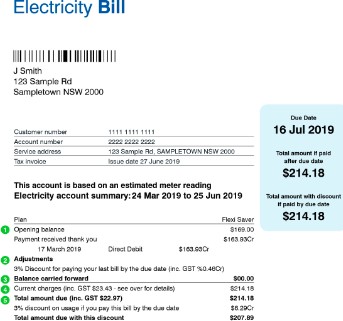Demystifying Your Electricity Bill: Understanding the Charges and Usage
An electricity bill is a document that is sent to a customer by an electricity company to notify them of the amount of electricity that they have used and the amount that they owe. The bill will typically include the following information:
- The customer's name and address
- The meter reading for the start of the billing period and the end of the billing period
- The amount of electricity used during the billing period
- The rate per kilowatt-hour (kWh)
- The total amount due
The bill may also include information about any discounts or credits that the customer is entitled to, as well as information about how to pay the bill.
Customers can pay their electricity bills in a variety of ways, including:
- By mail
- In person at a customer service center
- Over the phone
- Online
If a customer does not pay their electricity bill on time, they may be subject to late fees. In some cases, the electricity company may also shut off the customer's power.
Here are some tips for reducing your electricity bill:
- Unplug appliances when you are not using them.
- Turn off lights when you leave a room.
- Wash clothes in cold water.
- Air-dry your clothes instead of using the dryer.
- Install energy-efficient light bulbs.
- Insulate your home.
- Seal up any cracks or gaps around windows and doors.
- Consider switching to a renewable energy source, such as solar or wind power.
By following these tips, you can save money on your electricity bill and help to protect the environment.
Demystifying Your Electricity Bill: Understanding the Charges and Usage
Your monthly electricity bill is a reflection of your energy consumption and the associated charges. Understanding the components of your electricity bill can help you manage your energy usage, make informed decisions about energy-saving practices, and budget effectively. In this article, we will break down the various elements typically found on an electricity bill and provide insights into understanding your energy consumption and the costs associated with it.
- Meter Reading:The meter reading section of your electricity bill displays the recorded usage during the billing period. This is the actual measurement of the electricity consumed, typically in kilowatt-hours (kWh). It represents the primary factor that determines the total amount you owe for the billing cycle.
- Rate Structure:Electricity bills often include information about the rate structure applied to calculate your charges. The rate structure can vary based on factors such as your location, type of service (residential or commercial), and the utility company's pricing policies. Common rate structures include flat rates, time-of-use rates, tiered rates, and demand charges. Understanding the rate structure can help you anticipate how your energy usage affects your bill.
- Supply Charges:Supply charges on your electricity bill reflect the cost of generating and delivering electricity to your location. These charges cover the expenses incurred by the utility company to maintain power plants, transmission lines, distribution networks, and other infrastructure. Supply charges are typically calculated based on the amount of energy consumed, as measured by your meter reading.
- Delivery Charges:Delivery charges represent the cost of transporting electricity from the generation source to your home or business. These charges cover the operation and maintenance of the distribution system, including substations, transformers, and power lines. Delivery charges are separate from supply charges and are often based on factors such as the distance from the distribution center and the level of electricity demand in your area.
- Taxes and Fees:Your electricity bill may include taxes and fees levied by local or state governments. These can include sales tax, utility tax, or regulatory fees. The specific taxes and fees vary depending on your jurisdiction. Understanding these additional charges can help you better estimate the total cost of your electricity usage.
- Energy Usage Comparison:Some electricity bills provide a comparison of your energy usage over different billing periods or against average usage in your area. This information can give you insights into your consumption patterns and help you identify trends or changes in your energy usage. By analyzing this data, you can make adjustments to your habits and implement energy-saving strategies.
- Energy-Saving Tips:Many electricity bills include energy-saving tips or resources to help you reduce your energy consumption. These suggestions may range from simple behavioral changes, such as turning off lights when not in use, to more significant energy-efficiency upgrades, like installing programmable thermostats or switching to energy-efficient appliances. Implementing these tips can not only lower your electricity bill but also contribute to a greener and more sustainable lifestyle.

